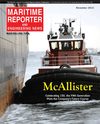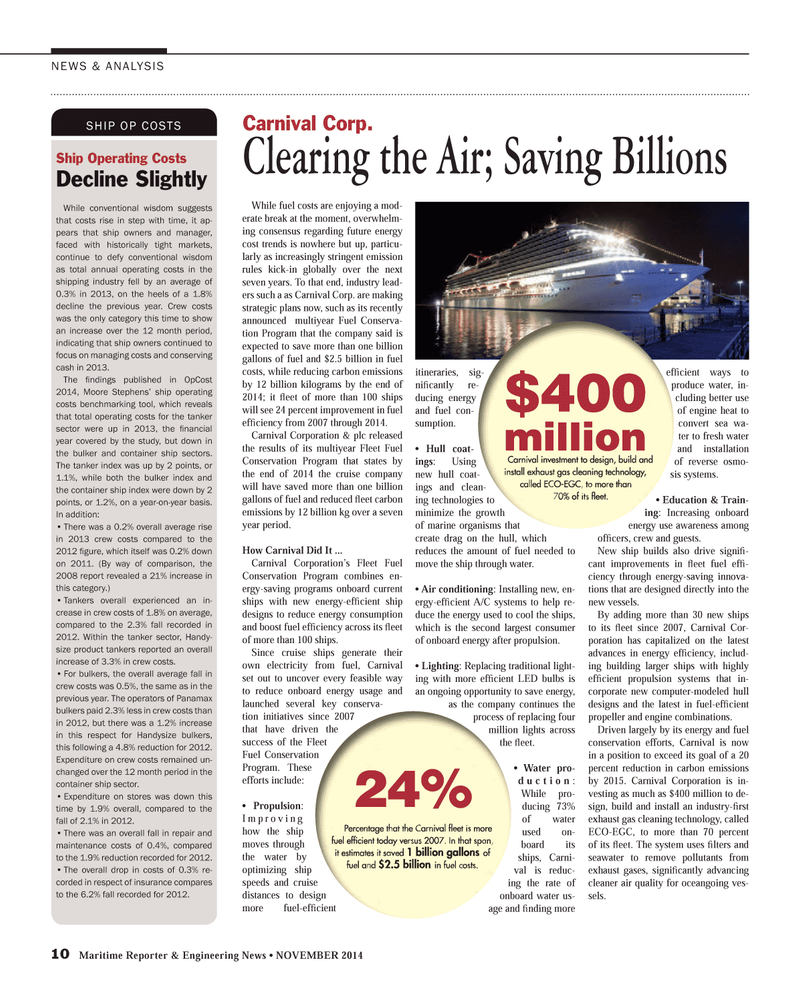
Page 10: of Maritime Reporter Magazine (November 2014)
Workboat Edition
Read this page in Pdf, Flash or Html5 edition of November 2014 Maritime Reporter Magazine
Ship Operating Costs
Decline Slightly
While conventional wisdom suggests that costs rise in step with time, it ap- pears that ship owners and manager, faced with historically tight markets, continue to defy conventional wisdom as total annual operating costs in the shipping industry fell by an average of 0.3% in 2013, on the heels of a 1.8% decline the previous year. Crew costs was the only category this time to show an increase over the 12 month period, indicating that ship owners continued to focus on managing costs and conserving cash in 2013.
The fi ndings published in OpCost 2014, Moore Stephens’ ship operating costs benchmarking tool, which reveals that total operating costs for the tanker sector were up in 2013, the fi nancial year covered by the study, but down in the bulker and container ship sectors.
The tanker index was up by 2 points, or 1.1%, while both the bulker index and the container ship index were down by 2 points, or 1.2%, on a year-on-year basis.
In addition: • There was a 0.2% overall average rise in 2013 crew costs compared to the 2012 fi gure, which itself was 0.2% down on 2011. (By way of comparison, the 2008 report revealed a 21% increase in this category.) • Tankers overall experienced an in- crease in crew costs of 1.8% on average, compared to the 2.3% fall recorded in 2012. Within the tanker sector, Handy- size product tankers reported an overall increase of 3.3% in crew costs. • For bulkers, the overall average fall in crew costs was 0.5%, the same as in the previous year. The operators of Panamax bulkers paid 2.3% less in crew costs than in 2012, but there was a 1.2% increase in this respect for Handysize bulkers, this following a 4.8% reduction for 2012.
Expenditure on crew costs remained un- changed over the 12 month period in the container ship sector. • Expenditure on stores was down this time by 1.9% overall, compared to the fall of 2.1% in 2012. • There was an overall fall in repair and maintenance costs of 0.4%, compared to the 1.9% reduction recorded for 2012. • The overall drop in costs of 0.3% re- corded in respect of insurance compares to the 6.2% fall recorded for 2012.
SHIP OP COSTS
While fuel costs are enjoying a mod- erate break at the moment, overwhelm- ing consensus regarding future energy cost trends is nowhere but up, particu- larly as increasingly stringent emission rules kick-in globally over the next seven years. To that end, industry lead- ers such a as Carnival Corp. are making strategic plans now, such as its recently announced multiyear Fuel Conserva- tion Program that the company said is expected to save more than one billion gallons of fuel and $2.5 billion in fuel costs, while reducing carbon emissions by 12 billion kilograms by the end of 2014; it ? eet of more than 100 ships will see 24 percent improvement in fuel ef? ciency from 2007 through 2014.
Carnival Corporation & plc released the results of its multiyear Fleet Fuel
Conservation Program that states by the end of 2014 the cruise company will have saved more than one billion gallons of fuel and reduced ? eet carbon emissions by 12 billion kg over a seven year period.
How Carnival Did It ...
Carnival Corporation’s Fleet Fuel
Conservation Program combines en- ergy-saving programs onboard current ships with new energy-ef? cient ship designs to reduce energy consumption and boost fuel ef? ciency across its ? eet of more than 100 ships.
Since cruise ships generate their own electricity from fuel, Carnival set out to uncover every feasible way to reduce onboard energy usage and launched several key conserva- tion initiatives since 2007 that have driven the success of the Fleet
Fuel Conservation
Program. These efforts include: • Propulsion:
Improving how the ship moves through the water by optimizing ship speeds and cruise distances to design more fuel-ef? cient itineraries, sig- ni? cantly re- ducing energy and fuel con- sumption. • Hull coat- ings: Using new hull coat- ings and clean- ing technologies to minimize the growth of marine organisms that create drag on the hull, which reduces the amount of fuel needed to move the ship through water. • Air conditioning: Installing new, en- ergy-ef? cient A/C systems to help re- duce the energy used to cool the ships, which is the second largest consumer of onboard energy after propulsion. • Lighting: Replacing traditional light- ing with more ef? cient LED bulbs is an ongoing opportunity to save energy, as the company continues the process of replacing four million lights across the ? eet. • Water pro- duction:
While pro- ducing 73% of water used on- board its ships, Carni- val is reduc- ing the rate of onboard water us- age and ? nding more ef? cient ways to produce water, in- cluding better use of engine heat to convert sea wa- ter to fresh water and installation of reverse osmo- sis systems. • Education & Train- ing: Increasing onboard energy use awareness among of? cers, crew and guests.
New ship builds also drive signi? - cant improvements in ? eet fuel ef? - ciency through energy-saving innova- tions that are designed directly into the new vessels.
By adding more than 30 new ships to its ? eet since 2007, Carnival Cor- poration has capitalized on the latest advances in energy ef? ciency, includ- ing building larger ships with highly ef? cient propulsion systems that in- corporate new computer-modeled hull designs and the latest in fuel-ef? cient propeller and engine combinations.
Driven largely by its energy and fuel conservation efforts, Carnival is now in a position to exceed its goal of a 20 percent reduction in carbon emissions by 2015. Carnival Corporation is in- vesting as much as $400 million to de- sign, build and install an industry-? rst exhaust gas cleaning technology, called
ECO-EGC, to more than 70 percent of its ? eet. The system uses ? lters and seawater to remove pollutants from exhaust gases, signi? cantly advancing cleaner air quality for oceangoing ves- sels.
NEWS & ANALYSIS 10 Maritime Reporter & Engineering News • NOVEMBER 2014
Carnival Corp.
Clearing the Air; Saving Billions
MR #11 (10-17).indd 10 11/4/2014 10:01:34 AM

 9
9

 11
11
